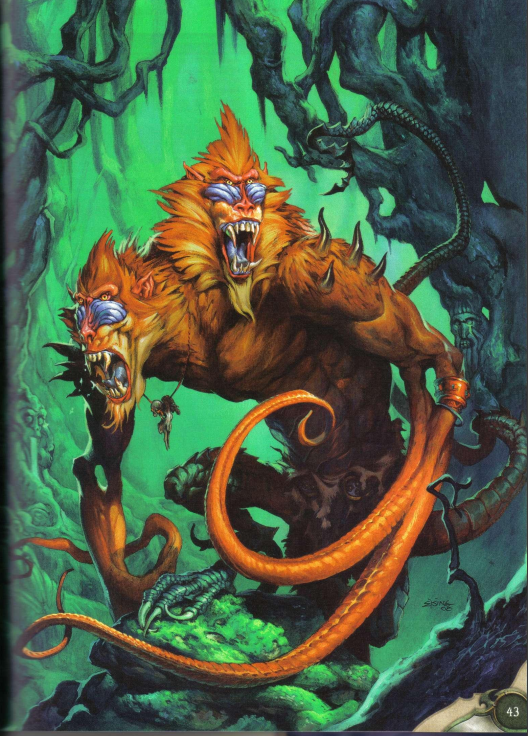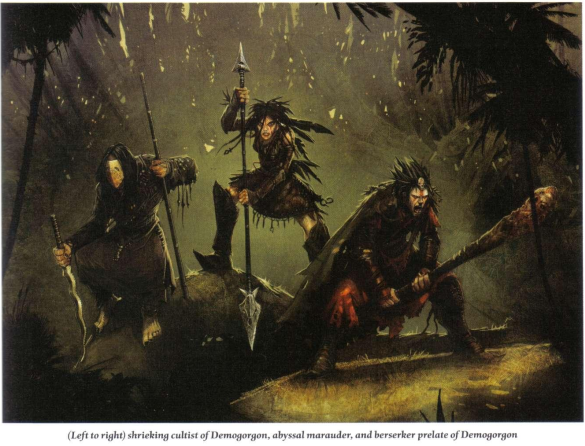Let's Read the 4e Monster Manual 2: Demogorgon (Part 1)

This article is part of a series! Click here to see the other entries.
We got to the Big Cheese of this book quite early, for his name starts with D: it’s Demogorgon! He’s been in the game since the days of AD&D 1st Edition. The name became quite famous when Stranger Things aired, though I don’t think it refers to the same creature.
This entry is like the Orcus entry in the MM1: It includes not only the stats for the titular demon lord but also its associates, aspects, exarchs, and even cultists. I’m going to go through them in reverse order, starting with the cultists and moving up the levels.
The Lore
Demogorgon is a demon lord’s demon lord. His credo is quite simple: through strength, cruelty and slaughter the strong prosper and the weak die. Be strong, be cruel, and slaughter the weak. That doesn’t mean he’s stupid, though! Each head has its own personality and highly developed intellect: Aameul is cunning but brutal and Hethradiah brutal but cunning. They hate each other and argue a lot but generally end up working towards compatible goals.
Demogorgon also has another business partner who is not himself, which makes him a bit unique among demon lords: Dagon, a Demon Lord inspired by the fishy entity of Lovecraftian fame. A keeper of secrets and cosmic mysteries, he shares these secrets with Demogorgon, but only whispers a given secret to one of the heads. This keeps their mutual hatred and jealousy going strong, and furthers Dagon’s own goals. Their servants and cults can be found cooperating some times.
We’ll eventually discuss the big bosses in more detail, but for now let’s begin by looking at their cults.
Cults of Demogorgon

Demogorgon’s cults gain prominence when war or other wide-ranging disasters ravage the land, as people turn to him in a desperate attempt to survive and end up becoming murderous marauders themselves. I imagine this tends to prolong the problem that caused the cult to rise in the first place. These cultists wander around like berserking pirates, pillaging and destroying everything in their path. What makes them different from, say, gnolls? Well, they’re more interested in taking your stuff than in eating you, and unlike gnolls or orcs they’re a very diverse crowd.
Members include individuals from any of the “civilized” species as well as troglodytes, kuo-toa and other aggressive humanoids. Note that none of them “naturally” worship Demogorgon: even troglodytes and kuo-toa typically venerate other deities. This means that every cultist of Demogorgon is a heretic to their own people. A lof of them were probably press-ganged into the cult during one of those raids I mentioned in the previous paragraph.
There are also some cultists who go deeper into the demon lord’s mysticism, believing that like their boss they are of two minds: a civilized mind who acts as a shackle to a an instinctive, destructive second self. Some try to explore this duality, while others try to cast of these shackles entirely, worshipping only Hethradiah, the most aggressive of the two heads.
Whatever their individual views, these cultists are all Chaotic Evil by any reasonable definition of the alignment.
Cults of Dagon
Dagon has his own cults too, and these are as Innsmouthy as you’d expect. His temples are undewater, though they include air-filled rooms to accommodate visiting terrestrial worshippers. These tend to congregate in coastal communities, and to sacrifice sapients to their master. Dagon’s demands grow with time, forcing his cultists to perform ever greater sacrifices in order to avoid being swallowed by tidal waves or other disasters sent by their overlord.
His worshippers also frequently include wizards and sages willing to bargain with him for some of those cosmic secrets. These tend to rise to the position of cult leaders. The most powerful among them might be able to visit Dagon personally in his doubly-abyssal domains, and barter legendary artifacts for the lore they seek.
Yeah, Vecna hates Dagon and their cults fight a lot. How did you guess?
The Numbers
We get quite a few cultist stat blocks here, all human. You can easily combine them with standard stat blocks from other humanoid species to get the diversity hinted at in the lore, or add the signature traits of those humanoids to the Demogorgon-flavored stat blocks from this entry.
Abyssal Marauder
Abyssal marauders roam the land in loose warbands, and the sea in rickety warships they barely know how to sail. When they see a village or ship, they attack, kill everyone, take what they can and burn what they can’t. In doing this they honor their demonic overlord.
Some pirate captains or land-bound warlords manage to hire bands of abyssal marauders to bolster their ranks for big raids, paying them mostly with the promise of plentiful loot and chances to kill people. Unless they can keep providing that loot between battles, though, it’s very hard to keep the marauders in line.
Marauders are Level 6 Skirmishers with 69 HP and a speed of 6. Their piecemeal protections are equivalent to leather armor, and they carry a long spear and a pair of throwing axes to battle.
Both the spear (reach 2 vs. AC) and the throwing axes (Ranged 5/10 vs. AC) count as basic attacks, and both allow the marauder to shift 1 square on a hit. They’ll usually open the fight with a Howling Charge, which allows them to throw an axe at someone and immediately charge them with the spear.
When bloodied, marauders are taken over by a Death Fury, which allows them to make two basic melee attacks per standard action at a -2 penalty to each. It also forbids them from using any of their other attacks!
Reach weapons and plentiful shifting make marauders work well when paired with a “wall” of sturdier allies, like the shrieking cultists we’ll see below.
Berserker Prelate of Demogorgon
Prelates are priest-types, preaching the credo of Demogorgon to their fellow cultists as their leader or (in the book’s words) their “spiritual pet”. Unlike the cultist priests of other demon lords, berserker prelates lead from the front and join the fight alongside their flock.
Prelates are Level 8 Controllers with the Leader keyword and 86 HP. Their speed is 5, they wear hide, and carry a big club into battle.
The greatclub is their basic melee attack, and allows them to push the target 1 square on a hit. At range they fling Abyssal Bolts (ranged 10 vs. Will) that do physical damage and slide the target 2 squares on a hit.
Their leadery skill is Bloodletter’s Call (Close Burst 3). Against enemies, this is an attack vs. Will that does psychic damage and dazes for a turn. On allies, it instead acts as a buff giving them +2 to attack for a turn.
As the name might imply, berserker prelates are gripped by the same Death Fury as their marauder buddies when bloodied.
Shrieking Cultist of Demogorgon
These psychos have given up on any semblance of restraint and rationality, seeking to emulate Hethradiah, the most violent of Demogorgon’s heads. When a lot of them gather, people who are themselves on the path to madness might discern the demonic hymn hidden in their collective shrieking.
These cultists are Level 7 Brutes with 94 HP. They wear mail, so their speed is 5. They wield a greataxe and carry a brace of javelins, which are basic attacks doing heavy damage as expected of a Brute. Once per encounter they can intensify their incoherent screaming into a Howl of Fury (close blast 3 vs. Will) that does psychic damage and immobilizes the targets for a turn on a hit.
They can also make their fury solid with Death Wrath (close burst 1 vs. AC; encounter), which does physical damage and creates a zone of horrible noise that moves with the cultist, in effect working like an aura 1. Anyone caught inside takes 5 physical damage.
Shrieking Cultists lack the Death Fury trait from their other two correligionists: for all practical purposes, they’re always in this state already.
Doom Flayer
Doom Flayers are wizards who worship Dagon to gain access to his secrets, offering sacrifices to him and helping further his plots. They will likely tell you they are perfectly rational and can stop the demon worship any time they want.
They’re Level 8 Artillery with 65 HP, wielding a dagger for emergencies and otherwise using a large collection of Dagon-themed spells to fight:
Force Lash (Ranged 10 vs. Reflex) does force damage and slows the target for a turn.
Grasping Tentacles (Ranged 10 vs. Fortitude; recharge 5-6) does physical damage and immobilizes (save ends). Until the target saves, any enemy starting its turn adjacent to the target is slowed (save ends).
Doom Foretold (Ranged 10; minor; encounter) auto-hits and makes the target grant combat advantage for a turn.
Churning Vortex (area burst 1 within 10 vs. Reflex; encounter) does physical damage, slides 1 square, and knocks the targets prone on a hit. It does half damage on a miss.
The encounter powers work as a good fight-opener, and you should use them that way or you might miss the chance to do so if the party decides to focus fire on the flayer.
Sample Encounters and Final Impressions
This entry has a bunch of sample encounters but only two are cultist-themed:
-
Level 7: 1 abyssal marauder, 2 shrieking cultists, 1 berserker prelate, and 1 tiefling darkblade. Remember what I said about using other stat blocks as cultists?
-
Level 7: 1 doom flayer, 2 troglodyte thrashers, 2 abyssal marauders, 1 gnaw demon. And here’s that Dagon/Demogorgon partnership at work.
D&D has a lot of hordes of murderous raiding cultists, and making them different from each other can be a tough job for a writer. I feel they succeeded here, though. Demogorgon’s cultists are the only ones with a diverse membership by the book, and the Death Fury trait makes them look properly “two-faced”, going from canny fighters to frothing nutjobs as the fight progresses.